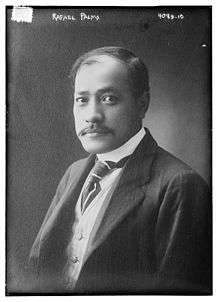Rafael Palma
Rafael Palma (Spanish pronunciation: [rafaˈel ˈpalma] : 24 October 1874 – 24 May 1939) was a Filipino politician, Rizalian, writer, educator and a famous Freemason. He was a senator from 1916 to 1921 and was the fourth President of the University of the Philippines.
Rafael Palma | |
|---|---|
 Rafael Palma in 1915 | |
| 4th President of the University of the Philippines | |
| In office 1925–1933 | |
| Preceded by | Guy Potter Benton |
| Succeeded by | Jorge Bocobo |
| Personal details | |
| Born | Rafael Palma y Velásquez October 24, 1874 Tondo, Manila, Captaincy General of the Philippines |
| Died | May 24, 1939 (aged 64) Manila, Commonwealth of the Philippines |
| Political party | Nacionalista Party |
| Spouse(s) | Carolina Ocampo |
| Alma mater | Ateneo de Manila University University of Santo Tomas |
Biography
Palma was born in Manila on 24 October 1874 to Don Hermógenes Palma, a clerk at the Intendencia Office, and Hilaria Velásquez. His younger brother was the soldier-poet José Palma, the author of the Spanish poem Filipinas, which is, along with its subsequent translations, used in the Philippine National Anthem.
In 1885, he began his studies at the Ateneo de Manila and graduated with a Bachelor of Arts degree. In 1892, he began his law studies at the University of Santo Tomas. While enrolled in the university, he was employed in the Office of the Bureau of Lands.[1]
He was also a reporter in La Independencia, the first Filipino daily newspaper, founded and directed by Antonio Luna. When Luna died in 1899, Palma assumed the paper's editorship. Aside from La Independencia, he was also involved in other papers, writing for La Patria, among others; and co-founding, along with Sergio Osmeña and Jaime de Veyra, El Nievo Dia, the first daily newspaper in Cebu.[1]
In 1901, he passed the bar examinations. That same year, he founded the newspaper El Renacimiento which was first published on September 3. He married Carolina Ocampo in February 1902.[2] He left the newspaper work in 1903 and practiced law while also teaching at the Escuela de Derecho.[1]
He started politics when he became a member and secretary of the Association of Peace. In the 1907 Philippine Assembly elections, he ran and subsequently won as an assemblyman representing the province of Cavite. In July 6, 1908, Governor-General James A. Smith appointed him as a member of the second Philippine Commission,[3] becoming the youngest member to serve up to 1916. In the 1916 Philippine Senate elections, he was elected as Senator representing the 4th District.[1]
In September 1916, he was appointed by Governor-General Francis B. Harrison, through Executive Order No. 64, as Secretary of Interior and served until his resignation on July 1920.[4][5] In July 1925, he was inaugurated as the fourth president of the University of the Philippines. He served as UP president up until 1933 when he resigned due to the Hare-Hawes-Cutting bill controversy wherein then-Senate President Manuel Quezon threatened to cut the university's appropriations due to Palma’s championing of the law.[6] He then again ran for Senator but lost to Juan Sumulong. In 1934, Palma was elected to the 1934 Constitutional Convention.[1]
In the later years of his life, Palma was appointed by President Quezon as Chairman of the National Board of Education.[2] He held that position until his death in Manila on May 24, 1939 at the age of 64.
Honours
Books
- The Pride of the Malay Race,[7] the English translation by Justice Román Ozaeta of Palma's biography of Filipino national hero José Rizal.
- The Woman and the Right to Vote[8]
- The New Mentality, 1929.
Places named after him
- Barangay Rafael Palma Real Estate Property, Diffun, Quirino.
- the building presently occupied by the Department of Justice and first named as University Hall was also previously named Palma Hall. A historical marker on the life of Rafael Palma is located at its ground floor.
- Palma Hall, which houses the College of Social Sciences and Philosophy of the University of the Philippines–Diliman, was named after him.
- University of Bohol, a private school in Tagbilaran, Bohol was named the Rafael Palma College in 1946 until it was given its present name.
- Palma Bridge, University of the Philippines Los Baños
- There are many other schools in the country which are named after Rafael Palma, like Rafael Palma Elementary School in Makati and Rafael Palma Elementary School, Zobel Roxas Street, Manila.
References
- "Rafael Palma". Senate of the Philippines. Retrieved October 20, 2019.
- "About Rafael Palma". The Philippine Diary Project. Retrieved October 20, 2019.
- War Department Annual Reports, 1908. VII. Washington, D. C.: Government Printing Office. 1909. p. 30.
- Official Gazette. XIV. 1916. p. 1843.
- Report of the Governor General of the Philippine Islands, Together with Reports of the Heads of the Departments of the Philippine Government, for the Fiscal Year Ended December 31, 1920. Washington, D. C.: Government Printing Office. 1923. p. 19.
- "MW Rafael Palma". The Most Worshipful Grand Lodge of Free and Accepted Masons of the Philippines. Retrieved October 20, 2019.
- http://www.articlearchives.com/government/elections-politics-politics/231814-1.html
- https://www.gutenberg.org/browse/authors/p#a32184
External links
- http://www.rafaelpalma147.org
- Works by Rafael Palma at Project Gutenberg
- http://www.glphils.org/kinship/palma.htm